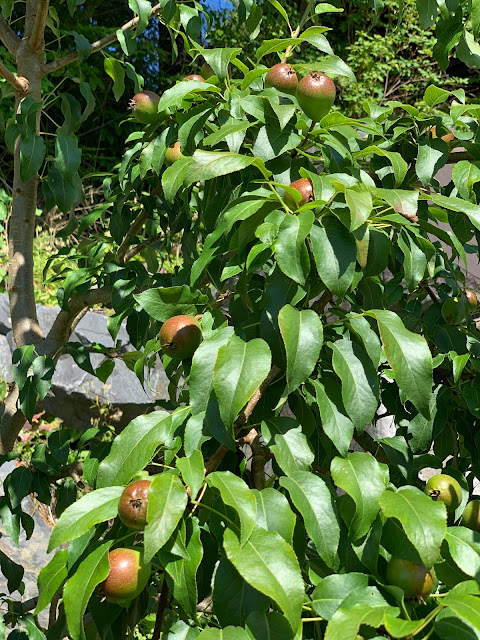Throughout my early teens, I was a babysitter. When I was not caring for my youngest brother and sister, I was babysitting neighbor kids. I don't know how it goes these days, but babysitters back then were expected to do chores after the children were put to bed... dishwashing, laundry, vacuuming. After chores, I would do homework. Some couples would stay out quite late socializing with friends until 1 or 2 AM. To stay awake, I would flip on the television. Not many channels or choices. There were talk shows, late movies and late, late movies... westerns, war movies and musicals. It is a corny song from one of those musicals that sometimes pops into my head, even still, when I am really happy about something. I must have resorted to watching this particular musical a dozen or more times. Ginger Rogers and Fred Astaire starred in the movie. They were about as old as my parents. While they waltzed around, Fred was singing, "Heaven, I'm in Heaven..."
That's the song I found myself singing when I saw pears ripening on our pear trees for the very first time!
YES, I LOVE PEARS. So, in the spring of 2013, I did some research about pears. Depending on variety and conditions, it can take up to 20 years to produce a healthy crop. The research made it clear that growing pear trees is not a sensible choice for impatient people. I thought about it and decided that I am a reasonably patient person. And, I reasoned that if we do not live long enough to see pears hanging on our trees, the next occupants of our home would have a head start.
So, I ordered seven different varieties of pear trees and planted them. Below are the names, descriptions and photos of the three varieties that produced full-sized, delicious fruit seven years later in the fall of 2020. As threatening as the year 2020 has been with horrible weather and a pandemic, we are still alive and well... and enjoying the wonderful flavor of pears! "Heaven, I'm in Heaven..."
Doyenne de Juillet
(Pyrus communis L.)
'Doyenne de Juillet', translates into Duchess of July/Summer. This European variety originated in Belgium and was purchased from Raintree Nursery.
The smallish fruit of 'Doyenne de Juillet' above gradually ripened from green to pale yellow with a red blush on the sunny side. The mature pear has white, juicy, sweet, flavorful flesh.
Shipova
(xSorbus auricularis)Originating in France centuries ago, the 'Shipova' pear was imported into the United States from Yugoslavia in 1959. Botanically rare, an intergeneric hybrid, 'Shipova' is a cross between the two different genera Sorbus and Pyrus. The specific varieties crossed were probably the Common European Pear and the Whitebeam Pear. Because Mountain Ash is also in the Sorbus family, it has been mistakenly claimed as one of the parents. Consequently, it is not surprising to see catalogs and tags with the following false or confusing taxonomies for 'Shipova' including the following:
One Green World
Raintree Nursery
Rolling River Nursery
The four pear trees listed below all had plenty of blooms in the spring of 2020. However, none of these trees produced mature fruit.
Two big issues of concern:
1. It was an unseasonably cold, wet spring causing many of the tender blooms to look brown and beat up.
2. There were far fewer pollinators flying around in spring compared with what we are accustomed to seeing. This was likely due to the aforementioned weather conditions. The pollinators showed up later in the season. Fair weather friends.
I feel pretty confident that these four trees will grow pears in 2021. I will keep you posted with updates if and when I start singing around any of these four pear trees.
Orcas European
(Pyrus communis L.)

Even though the 2022 season was not sunny, warm and wonderful, ORCAS produced 3 dozen delicious pears!
Below are the three varieties remaining fruitless.
They all had blossoms in the spring of 2021 and 2022. The blossoms simply could not endure the cold wind and rain.
I will visit these remaining three varieties often and cheer them on throughout the spring of 2023.
Stay tuned!
Bella di Giugno
(Pyrus communis L.)
Butirra Precoce Morettini
(Pyrus communis L.)
Ubileen
(Pyrus communis L.)
















Gunalcheesh so much for this wonderful post. It is clear, the pictures are beautiful and the whole thing is inspirational! You ROCK!!
ReplyDeleteGood to hear you enjoyed the post. I love that you wrote, "You ROCK!!" because I happen to be crazy about rocks. Hahaha!
DeleteI have ALWAYS wanted a pear tree..I plan to order 3 and hope I will see pears in my back yard one day. Thank you for sharing your knowledge and the beautiful pears.
ReplyDeleteHere's hoping for success!
DeleteFlorence, you are amazing!
ReplyDeleteHahaha! Thank you! I don't know about 'amazing' but for sure 'driven' a lot like you!
Delete